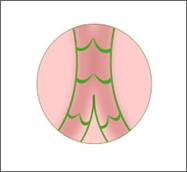| Deep Vein Problem |
| |
| Deep Vein Thrombosis |
Deep vein thrombosis (DVT) is a condition in which a blood clot (thrombus) develops in a deep vein usually in the leg or thigh and requires immediate medical care.
These clots are dangerous because they can break loose, travel through the bloodstream to the lungs, and block blood flow in the lungs (pulmonary embolism). If a pulmonary embolism occurs, there may be sudden sharp chest pain along with shortness of breath. If large enough, it may even be life-threatening.
If you are experiencing any of these symptoms, please go to your nearest emergency room as soon as possible. |
| |
 |
DVT can also lead to long-lasting problems. DVT may damage the vein and cause the leg to ache, swell, and change color. It can also lead to leg sores after years of having a DVT.
Blood clots most often develop in the calf and thigh veins, and less often in the arm veins or pelvic veins. This topic focuses on blood clots in the deep veins of the legs, but diagnosis and treatment of DVT in other parts of the body are similar. |
|
| What causes deep vein clots to form? |
| Blood clots can form in veins when you are inactive. For example, clots can form if you are paralyzed or bedridden or must sit while on a long flight or car trip. Surgery or an injury can damage your blood vessels and cause a clot to form. Cancer can also cause deep vein thrombosis. Protein abnormalities in the blood causing it to be "too thick" . Some people have blood that clots too easily, a problem that may run in families. |
| |
| What are the symptoms? |
Symptoms of DVT include significant swelling of the affected leg. Also, the leg may feel warm and look redder than the other leg. The calf or thigh may ache or feel tender when you touch or squeeze it or when you stand or move. Pain may get worse and last longer or become constant.
If a blood clot is small, it may not cause symptoms. In some cases, pulmonary embolism is the first sign that you have DVT. |
| |
| How is deep vein thrombosis diagnosed? |
| If your doctor suspects that you have DVT, you probably will have an color duplex doppler test to measure the blood flow through your veins and help find any clots that might be blocking the flow. Other tests, such as a venogram, are sometimes used if ultrasound results are unclear. A venogram is an X-ray test that takes pictures of the blood flow through the veins. |
| |
| How is it treated? |
| DVT and PE are serious medical conditions that need to be treated in the hospital. |
Treatment begins right away to reduce the chance that the blood clot will grow or that a piece of the clot might break loose and flow to your lungs.
Treatment for DVT usually involves taking blood thinners (anticoagulants) such as heparin and warfarin (Coumadin, for example). Heparin is given through a vein (intravenously, or IV) or as an injection. Warfarin is given as a pill. Treatment usually involves taking blood thinners for at least 3 months to prevent existing clots from growing and may need to be continued for several months or longer.
Your doctor may need to adjust the dose of your medicine. You will have blood tests often so he or she can see how well the blood thinners are working.
Your doctor also may recommend that you prop up or elevate your leg when possible, use a heating pad, take walks, and wear tight-fitting, elastic stockings (compression stockings). These measures may help reduce the pain and swelling that can happen with DVT. |
| |
If the DVT/PE is large enough, it may be necessary to perform one or more interventions by a vascular surgeon: |
- Dissolve the clot with medications and remove it from the vein
- Open up a narrowed leg or pelvic vein with a balloon or stent
- Place a filter in the vena cava to prevent DVT migration to the lungs
|
| In rare cases, a vena cava filter may be used. A vena cava filter is inserted into the vena cava, the large vein that returns blood to the heart from the abdomen and legs. A vena cava filter helps prevent blood clots from traveling to the lungs. This device is usually only used if a person is at high risk for pulmonary embolism and is not able to take blood thinners. It may also be used if you have DVT that comes back again or you had a sudden blockage of blood flow in the lung (pulmonary embolism) while taking blood thinners. |
The cause of the DVT also needs to be investigated. |
| |
| How can deep vein thrombosis be prevented? |
| There are things you can do to prevent deep vein thrombosis. Many doctors recommend that you wear compression stockings during a journey longer than 8 hours. On long flights, walk up and down the aisle hourly, flex and point your feet every 20 minutes while sitting, drink plenty of water, and avoid alcohol and beverages with caffeine. |
| |
| Chronic Venous Insufficiency (CVI) |
Many DVT’s will heal on their own with time and blood thinners. Unfortunately, the DVT may cause damage to the one-way valves in the deep veins, leading to backward blood flow (“reflux” or “insufficiency”). Instead of flowing from the foot back to the heart, blood may flow back down the leg through broken valves, causing high venous pressure.
This high pressure may cause leg swelling, spider veins, varicose veins, skin thickening, brownish skin discoloration, and even skin ulceration. If any of these are present, your doctor will order a vein duplex ultrasound to diagnose the specific problem. Treatment of these various problems depends on the specific cause, and may include any combination of treatments offered at Varicose Clinic & Laser Center. Some patients need no intervention other than counseling and a compression stocking for the leg. |
| |
|
|








